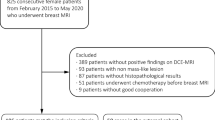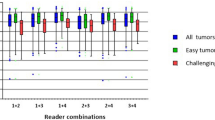Abstract
Purpose
A highly accurate and robust computer-aided system based on quantitative high-throughput Breast Imaging Reporting and Data System (BI-RADS) features from dynamic contrast-enhanced magnetic resonance imaging (DCE-MRI) can drive the success of radiomic applications in breast cancer diagnosis. We aim to build a stable system with highly reproducible radiomics features, which can make diagnostic performance independent of datasets bias and segmentation methods.
Method
We applied a dataset of 267 patients including 136 malignant and 131 benign tumors from two MRI manufacturers, where 211 cases from a Philips system and 55 cases from a GE system. First, manual annotations, 3D-Unet and 2D-Unet were applied as different segmentation methods. Second, we designed and extracted 3172 features from six modalities of DCE-MRI based on BI-RADS. Third, the feature selection was conducted. Between-class distance was utilized to eliminate the effect of dataset bias caused by two machines. Concordance correlation coefficient, intraclass correlation coefficient and deviation were employed to evaluate the influence of three segmentation methods. We further eliminated features redundancy using genetic algorithm. Finally, three classifiers including support vector machine (SVM), the bagged trees and K-Nearest Neighbor were evaluated by their performance for diagnosing malignant and benign tumors.
Results
A total of 246 features were preserved to have high stability and reproducibility. The final feature set showed the robust performance under these factors and achieved the area under curve of 0.88, the accuracy of 0.824, the sensitivity of 0.844, the specificity of 0.807 in differentiating benign and malignant tumors with the SVM classifier using manually segmentation results.
Conclusion
The final selected 246 features are reproducible and show little dependence on segmentation methods and data perturbation. The high stability and effectiveness of diagnosis across these factors illustrate that the preserved features can be used for prognostic analysis and help radiologists in the diagnosis of breast cancer.




Similar content being viewed by others
Explore related subjects
Discover the latest articles, news and stories from top researchers in related subjects.References
Siegel RL, Miller KD, Jemal A (2018) Cancer statistics, 2018. CA Cancer J Clin 60(5):277–300
Milosevic M, Jankovic D, Milenkovic A, Stojanov D (2018) Early diagnosis and detection of breast cancer. Technol Health Care 26(4):729–759
Hara N, Okuizumi M, Koike H, Kawaguchi M, Bilim V (2010) Dynamic contrast-enhanced magnetic resonance imaging (DCE-MRI) is a useful modality for the precise detection and staging of early prostate cancer. Prostate 62(2):140–147
Morris EA, Comstock CE, Lee CH (2013) ACR BI-RADS® Magnetic resonance imaging. In: ACR BI-RADS® Atlas, Breast Imaging Reporting and Data System. American College of Radiology, Reston, VA, pp 127–143
Agrawal G, Su MY, Nalcioglu O, Feig SA, Chen JH (2009) Significance of breast lesion descriptors in the ACR BI-RADS MRI lexicon. Cancer 115:1363–1380
Isensee F, Petersen J, Klein A, Zimmerer D, Jaeger PF, Kohl S (2018) Nnu-net: self-adapting framework for u-net-based medical image segmentation
David PM, Rusty OB (2013) Improving cross-device attacks using zero-mean unit-variance normalization. J Cryptogr Eng 3(2):99–110
Ronneberger O, Fischer P, Brox T (2015) U-net: convolutional networks for biomedical image segmentation. In: International conference on medical image computing and computer-assisted intervention, vol 1, pp 234–241
Hu Y, Qiao M, Guo Y, Wang Y, Yu J, Li J, Chang C (2017) Reproducibility of quantitative high-throughput BI-RADS features extracted from ultrasound images of breast cancer. Med Phys 44(7):3676–3685
Haralick RM, Shanmugam K, Dinstein I (1973) Textural features for image classification. Stud Media Commun (SMC) 3(6):610–621
Chu A, Sehgal CM, Greenleaf JF (1990) Use of gray value distribution of run lengths for texture analysis. Pattern Recognit Lett 11(6):415–419
Galloway MM (1975) Texture analysis using gray level run lengths. Comput Graph Image Process 4(2):172–179
Thibault G, Fertil B, Navarro C, Pereira S, Cau P, Levy N, Sequeira J, Mari J (2009) Texture indexes and gray level size zone matrix application to cell nuclei classification. In: 10th International conference on pattern recognition and information processing (Atlantic City, New Jersey), pp 140–145
Amadasun M, King R (1989) Textural features corresponding to textural properties. IEEE Trans Syst Man Cybern 19(5):1264–1274
Lin IK (1989) A concordance correlation coefficient to evaluate reproducibility. Biometrics 45(1):255–268
McGraw Kenneth O, Wong SP (1996) Forming inferences about some intraclass correlation coefficients. Psychol Methods 1(1):30–46
Qiao M, Hu Y, Guo Y, Wang Y, Yu J (2018) Breast tumor classification based on a computerized breast imaging reporting and data system feature system. J Ultrasound Med 37(2):403–415
Rebentrost P, Mohseni M, Lloyd S (2013) Quantum support vector machine for big feature and big data classification. Phys Rev Lett 113(13):130503
Sexton J, Laake P (2009) Standard errors for bagged and random forest estimators. Comput Stat Data Anal 53(3):801–811
Islam MJ, Wu QMJ, Ahmadi M, Sid-Ahmed MA (2010) Investigating the performance of Naive-Bayes classifiers and K-nearest neighbor classifiers. J Converg Inf Technol 5(2):133–137
Acknowledgements
This work was supported by the National Natural Science Foundation of China (Grant 61871135, 81627804 and 81830058) and the Science and Technology Commission of Shanghai Municipality (Grant 18511102901, 18511102904, 17411953400).
Author information
Authors and Affiliations
Corresponding authors
Ethics declarations
Conflict of interest
We have no conflict of interest to declare.
Ethical approval
All procedures performed in studies involving human participants were following the ethical standards of the institutional and/or national research committee and with the Declaration of Helsinki. Informed consent was obtained from all individual participants included in the study. This study has been approved by the ethics committee of the Renji Hospital.
Additional information
Publisher's Note
Springer Nature remains neutral with regard to jurisdictional claims in published maps and institutional affiliations.
Rights and permissions
About this article
Cite this article
Qiao, M., Li, C., Suo, S. et al. Breast DCE-MRI radiomics: a robust computer-aided system based on reproducible BI-RADS features across the influence of datasets bias and segmentation methods. Int J CARS 15, 921–930 (2020). https://doi.org/10.1007/s11548-020-02177-0
Received:
Accepted:
Published:
Issue Date:
DOI: https://doi.org/10.1007/s11548-020-02177-0




